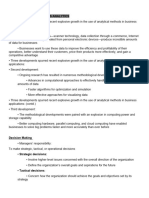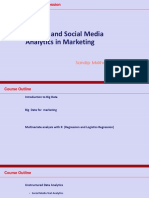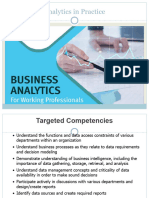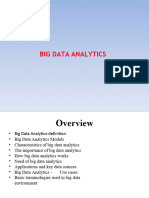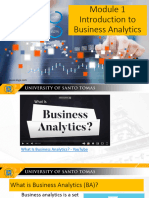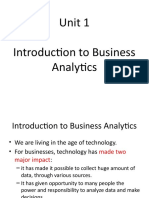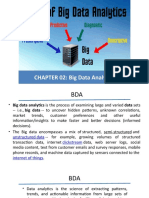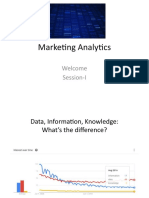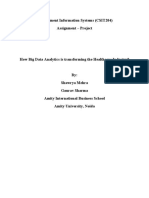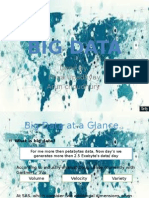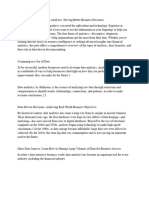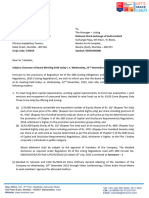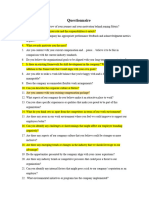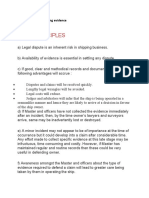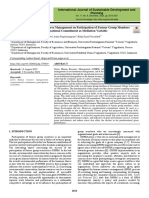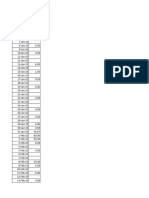Big data and Business
Analytics in Practice
�Big Data
Volume
Velocity
Variety
Veracity
2
�Big Data
• Walmart handles over 1 million purchase transactions per hour.
• Facebook processes more than 250 million picture uploads per day.
• Six billion cell-phone owners around the world generate vast amounts of
data by calling, texting, tweeting, and browsing the web on a daily basis.
• As Google CEO Eric Schmidt has noted, the amount of data currently
created every 48 hours is equivalent to the entire amount of data created
from the dawn of civilization until the year 2003.
�Big Data
Big data: A set of data that cannot be managed, processed, or analyzed
with commonly available software in a reasonable amount of time
• Represents opportunities
• Presents challenges in terms of data storage and processing, security, and
available analytical talent
• More companies are hiring data scientists who know how to process and
analyze massive amounts of data
4
�Figure 1.2: The 4 Vs of Big Data
�Big Data
• Volume
• To be useful, these data must be stored, and this storage has led to vast quantities of data.
Many companies now store in excess of 100 terabytes of data (a terabyte of data is 100,000
gigabytes).
• Velocity
• Real-time capture and analysis of data present unique challenges both in how data are
stored and the speed with which those data can be analyzed for decision making.
• Variety
• More complicated types of data are now available and are proving to be of great value to
businesses.
• Text data, Audio data, Video data
• Veracity
• Veracity has to do with how much uncertainty is in the data.
�Big Data
• The four Vs have led to new technologies
• Hadoop: An open-source programming environment that supports big data
processing through distributed storage and processing over multiple
computers
• MapReduce: A programming model used within Hadoop that performs two
major steps: the map step and the reduce step
• Data security: The protection of stored data from destructive forces
or unauthorized users
�Business Analytics in
Practice
Financial Analytics Supply-Chain Analytics
Human Resource (HR) Analytics Analytics for Government and Nonprofits
Marketing Analytics Sports Analytics
Health Care Analytics Web Analytics
8
�Figure 1.3:
The Spectrum of Business Analytics
�Business Analytics in Practice
• Predictive and prescriptive analytics are sometimes referred to as
advanced analytics
• Financial analytics
• Use of predictive models to:
• Forecast future financial performance
• Assess the risk of investment portfolios and projects
• Construct financial instruments such as derivatives
• Construct optimal portfolios of investments
• Allocate assets
• Create optimal capital budgeting plans
• Simulation is also often used to assess risk in the financial sector
10
�Business Analytics in Practice
Human resource (HR) analytics
• New area of application for analytics
• The HR function is charged with ensuring that the organization:
• Has the mix of skill sets necessary to meet its needs
• Is hiring the highest-quality talent and providing an environment that retains it
• Achieves its organizational diversity goals
11
�Business Analytics in Practice
Marketing analytics
• Marketing is one of the fastest growing areas for the application of analytics
• A better understanding of consumer behavior through the use of scanner
data and data generated from social media has led to an increased interest in
marketing analytics
12
�Business Analytics in Practice
Marketing analytics (contd.)
• A better understanding of consumer behavior through marketing analytics
leads to:
• Better use of advertising budgets
• More effective pricing strategies
• Improved forecasting of demand
• Improved product line management
• Increased customer satisfaction and loyalty
13
�Figure 1.4: Google Trends for Marketing, Financial,
and Human Resource(HR) Analytics, 2006–2015
14
�Business Analytics in Practice
• Health care analytics
• Descriptive, predictive, and prescriptive analytics are used to improve:
• Patient, staff, and facility scheduling
• Patient flow
• Purchasing
• Inventory control
• Use of prescriptive analytics for diagnosis and treatment
15
�Business Analytics in Practice
• Supply chain analytics
• The core service of companies such as UPS and FedEx is the efficient delivery
of goods, and analytics has long been used to achieve efficiency
• The optimal sorting of goods, vehicle and staff scheduling, and vehicle routing
are all key to profitability for logistics companies such as UPS, FedEx, and
others like them
• Companies can benefit from better inventory and processing control and
more efficient supply chains
16
�Business Analytics in Practice
• Analytics for government to:
• Drive out inefficiencies
• Increase the effectiveness and accountability of programs
• Example: tax collection
• Use data mining to identify patterns that distinguish questionable annual personal
income tax filings
17
�Business Analytics in Practice
• Analytics for nonprofit agencies to:
• Ensure their effectiveness and accountability to their donors and clients
• Use an analytical spreadsheet model to assist in the allocation of its annual
budget based on the impact that its various relief efforts and programs will
have in different countries.
�Business Analytics in Practice
• Sports analytics
• Professional sports teams use to:
• Assess players for the amateur drafts
• Decide how much to offer players in contract negotiations
• Professional motorcycle racing teams that use sophisticated optimization for
gearbox design to gain competitive advantage
• Teams use to assist with on-field decisions such as which pitchers to use in
various games of a MLB playoff series
19
�Business Analytics in Practice
• Sports analytics (contd.)
• The use of analytics for off-the-field business decisions is also increasing
rapidly
• Using prescriptive analytics, franchises across several major sports
dynamically adjust ticket prices throughout the season to reflect the relative
attractiveness and potential demand for each game
20
�Business Analytics in Practice
Web analytics
• The analysis of online activity, which includes, but is not limited to, visits to
web sites and social media sites such as Facebook and LinkedIn
• Leading companies apply descriptive and advanced analytics to data collected
in online experiments to determine the best way to:
• Configure web sites
• Position ads
• Utilize social networks for the promotion of products and services
21
�Summary
• Big data too large or too complex to be handled by standard data
processing techniques.
• Leading to an increase in the use of analytics.
• Business analytics is helping them understand these data and use
them to make better decisions.
�Summary
• Our discussion focused on financial analytics, human resource
analytics, marketing analytics, health care analytics, supply-chain
analytics, analytics for government and nonprofit organizations,
sports analytics, and web analytics.
• The use of analytics is rapidly spreading to other sectors, industries,
and functional areas of organizations.



